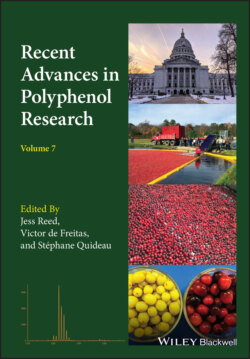Читать книгу Recent Advances in Polyphenol Research - Группа авторов - Страница 16
1.3 Extending the Multistate of Anthocyanins and Related Compounds to the Basic Region
ОглавлениеIn many flavylium derivatives from natural or synthetic origin, including anthocyanins, it is indispensable to extend the multistate study to basic medium.
In order to account for these new species, eight equilibrium equations should be added to eq. (1) through eq. (4).
For the formation of the mono‐anionic species1
(5)
(6)
(7)
(8)
And for the formation of the di‐anionic species
(9)
(10)
(11)
(12)
The system can be generalized for higher charged anionic species.
In spite of the complexity of this system, the set of eqs. 1 through 12 can be simplified considering a triprotic acid, eq. (13) through eq. (15), with constants K’a, eq. (19) K”a, eq. (20), and K”’a, eq. (21). The complete mathematical development of the system above was previously reported (supplementary information, Mendoza et al. 2019) and is straightforwardly obtained from a mass balance and representation of all species as a function of AH+.
(13)
(14)
(15)
Where
(16)
(17)
(18)
and
(19)
(20)
(21)
The mole fraction distribution XR of all species can be expressed in terms of the 12 linearly independent constants reported in Scheme 1.3. Since the flavylium cation and the quinoidal bases are in very fast equilibrium (microseconds scale), it is convenient to consider them altogether. The same is valid for the other species related through the proton transfer reaction.
(22)
where
(23)
(24)
(25)
(26)
Scheme 1.3 Extension to the basic medium of Pelargonidin‐3‐glucoside.
Figure 1.2 Absorption spectrum of heavenly blue anthocyanin, a peonidin derivative, black full line, flavylium cation; black pointed line, quinoidal base; black traced line, ionized quinoidal base. pK’a=3.47; pK”a=7.05; pK”’a=8.30.
Source: Mendoza et al. 2018.
Since the complex system shown in Scheme 1.3 behaves as a simple triprotic acid, the respective apparent equilibrium constants K’a, K”a, and K”’a are experimentally obtained from the inflection points of the absorbance representation as a function of the pH. Consequently, the term D is a parameter obtained experimentally. In Figure 1.2 the example of the heavenly blue anthocyanin is shown (Mendoza et al. 2018).
The question now is to define the experimental strategy to calculate the equilibrium constants of the system.
